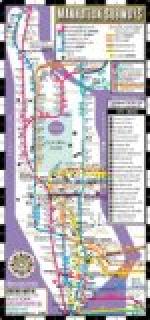Under Broadway, Manhattan, the work is through sand, the vehicular and electric street car traffic, the network of subsurface structures, and the high buildings making this one of the most difficult portions of the road to build. The street traffic is so great that it was decided that during the daytime the surface of the street should be maintained in a condition suitable for ordinary traffic. This was accomplished by making openings in the sidewalk near the curb, at two points, and erecting temporary working platforms over the street 16 feet from the surface. The excavations are made by the ordinary drift and tunnel method. The excavated material is hoisted from the openings to the platforms and passed through chutes to wagons. On the street surface, over and in advance of the excavations, temporary plank decks are placed and maintained during the drifting and tunneling operations, and after the permanent subway structure has been erected up to the time when the street surface is permanently restored. The roof of the subway is about 5 feet from the surface of the street, which has made it necessary to care for the gas and water mains. This has been done by carrying the mains on temporary trestle structures over the sidewalks. The mains will be restored to their former position when the subway structure is complete.
From Bowling Green, south along Broadway, State Street and in Battery Park, where the subway is of reinforced concrete construction, the “open cut and cover” method is employed, the elevated and surface railroad structures being temporarily supported by wooden and steel trusses and finally supported by permanent foundations resting on the subway roof. From Battery Place, south along the loop work, the greater portion of the excavation is made below mean high-water level, and necessitates the use of heavy tongue and grooved sheeting and the operation of two centrifugal pumps, day and night.
The tubes under the East River, including the approaches, are each 6,544 feet in length. The tunnel consists of two cast-iron tubes 15-1/2 feet diameter inside, the lining being constructed of cast-iron plates, circular in shape, bolted together and reinforced by grouting outside of the plates and beton filling on the inside to the depth of the flanges. The tubes are being constructed under air pressure through solid rock from the Manhattan side to the middle of the East River by the ordinary rock tunnel drift method, and on the Brooklyn side through sand and silt by the use of hydraulic shields. Four shields have been installed, weighing 51 tons each. They are driven by hydraulic pressure of about 2,000 tons. The two shields drifting to the center of the river from Garden Place are in water-bearing sand and are operated under air pressure. The river tubes are on a 3.1 per cent. grade and in the center of the river will reach the deepest point, about 94 feet below mean high-water level.




